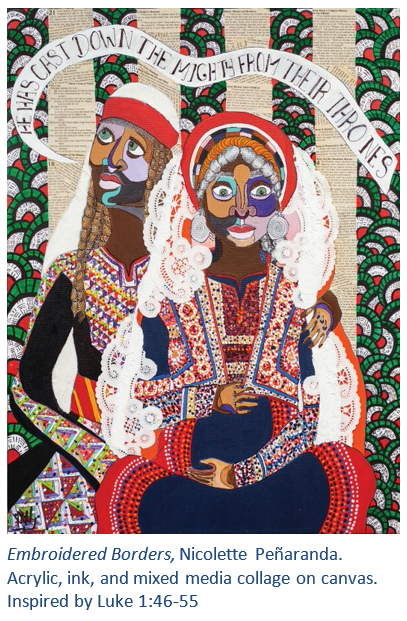 My heart shall sing of the day you bring. Let the fires of your justice burn. Wipe away all tears, for the dawn draws near, and the world is about to turn. ~Canticle of the Turning, Rory Cooney, 1990 How does a weary world rejoice? One answer is while singing songs of hope. Or to be more specific, singing together songs of hope. Hope for a world where there is no more war, no more hunger, no more crying, no more homelessness. No more of all the things that we seem to have taken a millennium or two to try and navigate and that are still present. So what is it about the people’s song that seems to be so important? This week’s readings include two of the central canticles (sacred hymns) of the birth narrative in the Gospel of Luke: the song of Mary (Magnificat: I magnify) and the song of Zechariah (The Benedictus: Blessing). So much singing! And in the daily prayers of people throughout the world, these canticles are sung every day. We now know that singing together makes things happen. Our heart rates start to match up, our anxieties lessen, and communities are formed. The science of it all is something that singers have known all along. Our Christmas celebrations are sometimes planned around singing and music. If it was good enough for the angels, it must be something we do too! But singing is something we also do to keep going when times are tough, when we are weary. We know of singing during times of protests. In our country, the civil rights movement was filled with songs of hope, songs of what the new world could be like. We also know that songs can be something that distracts us from reality. We can be nostalgic for carols that take us out of the world, that takes the humanity out of Jesus (no crying he makes?) , or are just too much fun to sing for us to also think about the text. “O Holy Night” has a verse that is left out many times because it is too “political.” But the birth of John and the birth of Jesus were smack dab in the middle of political times where the powerful threatened the voiceless people with torture and death, many times to keep them voiceless. And yet, the people continue to sing. Readings: Zephaniah 3:14-20 † Luke 1:46-55 † Luke 1:67-80 Join us for worship. Sunday morning at 10:00am in-person or online. About the Art: Embroidered Borders, Nicolette Peñaranda. Acrylic, ink, and mixed media collage on canvas. Inspired by Luke 1:46-55.
From the Artist:
Two years before the birth of Jesus, during the Pax Romana, one of the worst public executions happened a half day’s walk away from where Mary grew up. She came of age during a time of occupation, more than likely unable to recall a time of true peace and liberation. Mary’s song rings of a dream that not only she but her ancestors dreamed of, and she would be the one to give birth to the savior of her people. Fast forward thousands of years and the same land where Mary grew up is still being occupied. One can imagine that the cries for liberation and the prayers for justice still ring down the streets of Bethlehem. To me, Mary’s song of praise is still valid for the women of Palestine and for the people who still raise their children under the duress of war and occupation. This image is a nod to Palestine. The background operates as a foundation, built with the colors of the Palestinian flag and with collaged scriptures that celebrate women. Elizabeth and Mary are both in Palestinian regalia but from different generations. Elizabeth, centered and holding her belly, is in an outfit inspired by a photograph of a woman from Ramallah, dated sometime between 1929-1946.4 This was intended to emphasize the generational differences between the two. Mary, on the other hand, is in more contemporary Palestinian fashion. A stipple effect was used to highlight the intricacy of Palestinian embroidery in both garments. What felt important to me is the placement of Mary and Elizabeth. Rarely does Elizabeth get to be the center of the story, as her pregnancy becomes an accompaniment piece to the birth of Jesus. But here, Elizabeth is in the foreground. She gets to be the star while Mary places her arms around her, comforting her, and proclaiming the good news of what is to come. Mary is the hope that we see in all youth.
0 Comments
Leave a Reply. |
worshipYou'll find here links to weekly worship and, where applicable archived service videos. Archives
July 2024
Categories |
 RSS Feed
RSS Feed